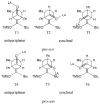Diastereoselectivity in Lewis-acid-catalyzed Mukaiyama aldol reactions: a DFT study
- PMID: 22891640
- PMCID: PMC3465709
- DOI: 10.1021/ja3052975
Diastereoselectivity in Lewis-acid-catalyzed Mukaiyama aldol reactions: a DFT study
Abstract
The basis for diastereoselectivity in Lewis-acid-catalyzed Mukaiyama aldol reactions was studied using density functional theory. By exploring the conformations of the transition structures for the diastereodifferentiating step of seven different reactions, simple models were generated. The effects of varying the substituents on the enol carbon and the α-carbon of the silyl enol ether from methyl to tert-butyl groups and the substituent on the aldehyde from methyl to phenyl groups were investigated by comparison of the transition structures for different reactions. Expanding on the previous qualitative models by Heathcock and Denmark, we found that while the pro-anti pathways take place via antiperiplanar transition structures, the pro-syn pathways prefer synclinal transition structures. The relative steric effects of the Lewis acid and trimethyl silyl groups and the influence of E/Z isomerism on the aldol transition state were investigated. By calculating 36 transition structures at the M06/6-311G*//B3LYP/6-31G* level of theory and employing the IEFPCM polarizable continuum model for solvation effects, this study expands the mechanistic knowledge and provides a model for understanding the diastereoselectivity in Lewis-acid-catalyzed Mukaiyama aldol reactions.
Conflict of interest statement
The authors declare no competing financial interest.
Figures









Similar articles
-
Enantioselective aldol reactions catalyzed by chiral phosphine oxides.Chem Rec. 2013 Aug;13(4):362-70. doi: 10.1002/tcr.201300004. Epub 2013 Jul 4. Chem Rec. 2013. PMID: 23828817 Review.
-
N-triflylthiophosphoramide catalyzed enantioselective Mukaiyama aldol reaction of aldehydes with silyl enol ethers of ketones.Org Lett. 2010 Jun 4;12(11):2476-9. doi: 10.1021/ol100233t. Org Lett. 2010. PMID: 20465277 Free PMC article.
-
Divergent stereocontrol of acid catalyzed intramolecular aldol reactions of 2,3,7-triketoesters: synthesis of highly functionalized cyclopentanones.Org Lett. 2012 Jul 20;14(14):3608-11. doi: 10.1021/ol301317a. Epub 2012 Jun 28. Org Lett. 2012. PMID: 22738671 Free PMC article.
-
Stereoselectivity in (Acyloxy)borane-Catalyzed Mukaiyama Aldol Reactions.J Org Chem. 2016 Jul 1;81(13):5314-21. doi: 10.1021/acs.joc.6b00594. Epub 2016 Jun 13. J Org Chem. 2016. PMID: 27247023
-
Current progress in the asymmetric aldol addition reaction.Chem Soc Rev. 2004 Feb 20;33(2):65-75. doi: 10.1039/b202901d. Epub 2004 Jan 20. Chem Soc Rev. 2004. PMID: 14767502 Review.
Cited by
-
Mukaiyama aldol reaction: an effective asymmetric approach to access chiral natural products and their derivatives/analogues.RSC Adv. 2023 Nov 8;13(47):32975-33027. doi: 10.1039/d3ra05058k. eCollection 2023 Nov 7. RSC Adv. 2023. PMID: 38025859 Free PMC article. Review.
-
Lewis base catalysis of the Mukaiyama directed aldol reaction: 40 years of inspiration and advances.Angew Chem Int Ed Engl. 2013 Aug 26;52(35):9086-96. doi: 10.1002/anie.201302084. Epub 2013 Jul 10. Angew Chem Int Ed Engl. 2013. PMID: 23843275 Free PMC article. Review.
References
-
- Mukaiyama T, Narasaka K, Banno K. Chem Lett. 1973;2:1011–1014.
-
- Mukaiyama T, Banno K, Narasaka K. J Am Chem Soc. 1974;96:7503–7509.
-
- Saigo K, Osaki M, Mukaiyama T. Chem Lett. 1975;4:989–990.
-
- Gennari C, Bernardi A, Cardani S, Scolastico C. Tetrahedron Lett. 1985;26:797–800.
-
- Mahrwald R. Modern aldol reactions. Wiley-VCH; Weinheim: 2004. pp. 139–140.
Publication types
MeSH terms
Substances
Grants and funding
LinkOut - more resources
Full Text Sources
Miscellaneous

